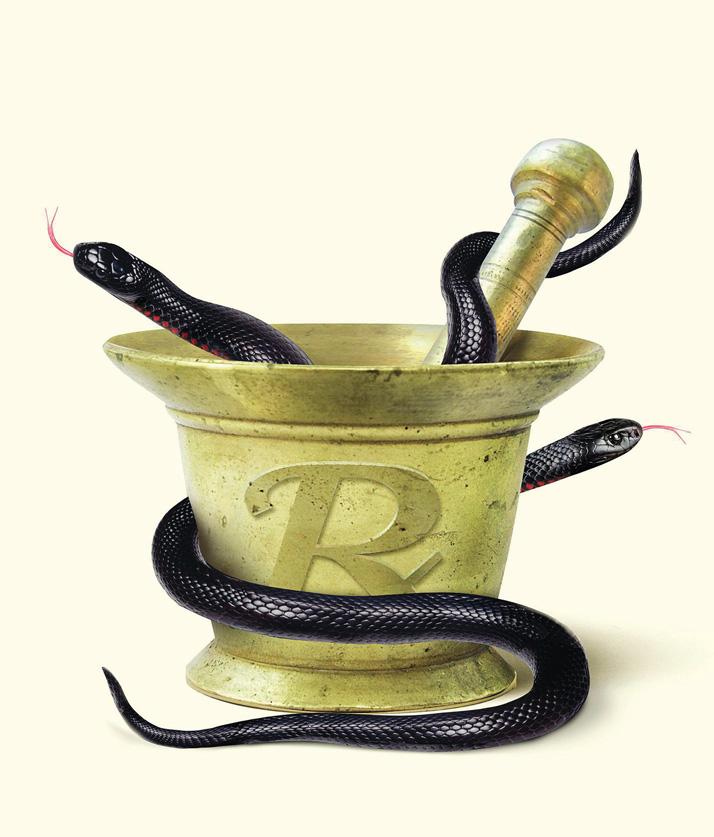America's drug middlemen are now a $557 billion industry. Can Trump and his allies 'knock out' PBMs?
Fortune US
|February - March 2025
IN LATE DECEMBER, President-elect Donald Trump put pharmacy benefit managers, or PBMs, on notice.

Denouncing the $557 billion industry as “horrible middlemen,” responsible for—and “rich as hell” from—America’s incomparably high prescription drug prices, Trump vowed to get rid of them. “We’re going to knock out the middlemen,” he said at a press conference at Mar-a-Lago.
Trump is hardly the first to go after PBMs. They make up an industry whose stated purpose is to help employers and other health care purchasers lower the cost of drugs, but for decades they’ve been accused of doing the opposite—and driving up spending through opaque, profit-driven pricing tactics.
Indeed, condemnation of PBMs is one of the rare points where Trump can find common cause with progressive lawmakers like Elizabeth Warren and activist regulators at Joe Biden’s Federal Trade Commission, which dropped a report just days before Trump’s inauguration accusing the biggest PBMs of price gouging. At a time when consumers’ frustration with the health care system has reached new peaks, taking on these little-understood players could give the government a bipartisan win with huge potential impact.
It’s little wonder that discontent with PBMs is so widespread. Americans spend more on medications than other countries—roughly twice as much per capita. By every measure, that spending is on the rise; by drug “list price,” the increase is astronomical—from $636 billion in 2018 to $917 billion in 2023. What exactly are PBMs saving us from, you might ask.
Employers and other health care payers despise PBMs' lack of transparency; pharmacies complain their high jinks are driving them out of business. Consumers may not know PBMs by name, but the drug-access and cost issues that frustrate and frighten them often stem from PBMs' decisions. More than half of U.S. adults worry about being able to afford prescription drugs; 30% couldn't afford them at some point last year.
यह कहानी Fortune US के February - March 2025 संस्करण से ली गई है।
हजारों चुनिंदा प्रीमियम कहानियों और 10,000 से अधिक पत्रिकाओं और समाचार पत्रों तक पहुंचने के लिए मैगज़्टर गोल्ड की सदस्यता लें।
क्या आप पहले से ही ग्राहक हैं? साइन इन करें
Fortune US से और कहानियाँ

Fortune US
GET READY TO OWN A TOKENIZED PORTFOLIO
A BLOCKCHAIN \"FREIGHT TRAIN\" IS ALREADY REMAKING WALL STREET'S FINANCIAL PLUMBING. IT COULD MAKE TRADING EVEN FASTER AND CHEAPER
6 mins
December 2025 - January 2026
Fortune US
RESOURCES HOW RARE EARTHS BECAME GROUND ZERO IN THE U.S.-CHINA RIVALRY
THE WATERSHED moment came in July when the federal government became the largest shareholder of MP Materials, a California miner of rare earth elements.
2 mins
December 2025 - January 2026

Fortune US
PASSIONS A BLISSFUL ESCAPE FROM DECISION FATIGUE
THE TASTING MENU at Uberto ends, like many others at restaurants of this caliber, with mignardises.
4 mins
December 2025 - January 2026

Fortune US
JAMIE DIMON OF JPMORGAN CHASE ON STEERING AMERICA'S BIGGEST BANK THROUGH 'INFLATIONARY' TIMES
CEO JAMIE DIMON has led JPMorgan Chase through periods of rapid change and epic turmoil—and Jan. 1, 2026, will be his 20th anniversary in the role.
6 mins
December 2025 - January 2026

Fortune US
WHAT TO BUY, AND NOT BUY, IN 2026
THREE YEARS OF EUPHORIA IN STOCKS AND OTHER ASSETS HAVE INVESTORS BRACING FOR TROUBLE. HERE'S WHAT TO DO IF BAD NEWS ARRIVES.
7 mins
December 2025 - January 2026

Fortune US
Breaking the Mold
The Trade Desk's Al-powered platform and open-web ethos has propelled it onto the S&P 500.
2 mins
December 2025 - January 2026

Fortune US
WINE TARIFF THREATS AND GEN Z SOBRIETY HAVE PUT BORDEAUX ON RED ALERT
IN THE TASTING room of a Bordeaux winery, a photo on the wall shows a pastoral tableau: three generations of the Dubois family, sipping wine on the patio of their Les Bertrands château, with their Australian shepherd, Namek, perched at their feet.
6 mins
December 2025 - January 2026

Fortune US
HOW AN AI BUBBLE COULD RUIN THE PARTY
IF AI REVENUE DOESN'T CATCH UP WITH AI SPENDING, GLOBAL STOCKS WILL BE AT RISK.
6 mins
December 2025 - January 2026

Fortune US
INNOVATION IS THE ERA OF ROBOT-DRIVEN UNEMPLOYMENT ALMOST UPON US?
AT A PRESS EVENT LAST YEAR, Amazon Robotics chief technologist Tye Brady told Fortune that the idea that there's a battle of robots versus humans inside Amazon's warehouse network is a “myth.”
5 mins
December 2025 - January 2026

Fortune US
Nvidia is invincible. Unless it isn't.
The doubters are coming for the world's most valuable company.
11 mins
December 2025 - January 2026
Listen
Translate
Change font size

